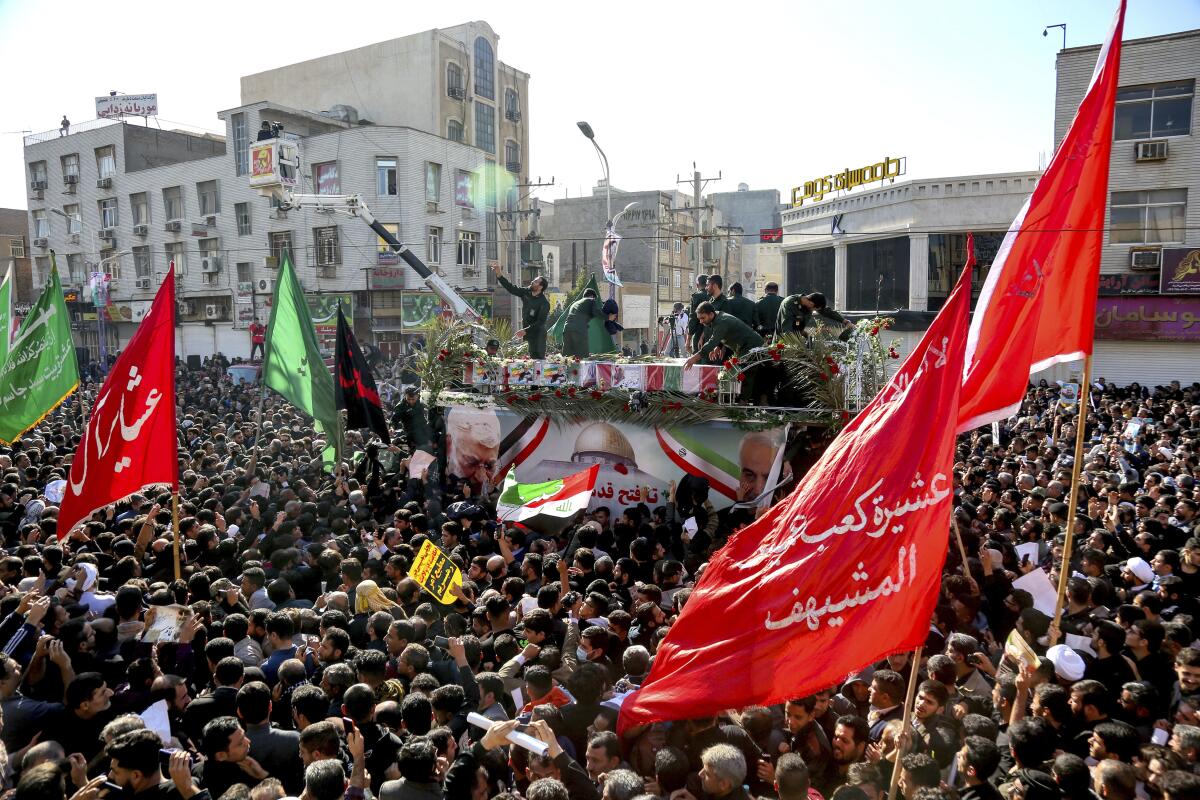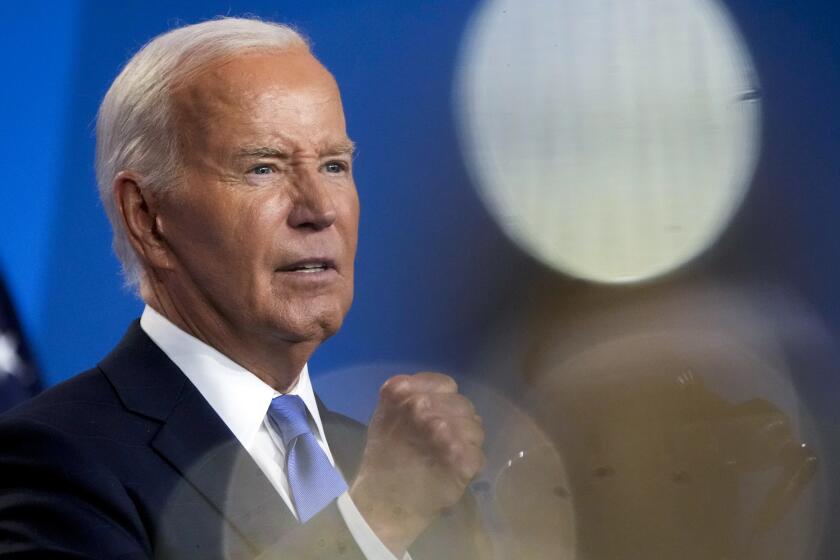Op-Ed: Trump says he wants out of costly foreign wars. But his actions say otherwise

How can the United States draw back from endless costly foreign wars? President Trump campaigned on a promise to do just that. He presented himself as a Washington outsider who could push aside the foreign policy establishment, which has a habit of getting entrapped in Mideast quagmires.
Certainly, that policy goal remains popular across the political spectrum. There’s just one problem: Trump’s tactics could never achieve that objective. Altering American foreign policy while maintaining national security imperatives is never a matter of just pulling the plug. Ending armed conflicts actually requires a long-term strategy and disciplined execution at every step. Every action Trump has taken in the Middle East has been quite the opposite, and has made it even harder for the U.S to leave the region.
Just look at his abrupt decision last week to kill Gen. Qassem Suleimani. Trump said he ordered the drone strike against the Iranian general “to stop a war, not to start a war.” But with Iran’s retaliatory attacks on Tuesday on U.S bases in Iraq, it’s clear the chances of a full-blown U.S-Iran conflict are higher now than they have been in decades.
Trump suggested on Wednesday morning he would back away from additional military action against Iran, assuming Iran doesn’t escalate the crisis further. But already this week, the U.S. deployed more troops to the Middle East, and embassies and citizens are on high alert. Islamic State fighters appear poised to gain, as the Suleimani killing removed one of their most effective adversaries from the battlefield and caused the U.S.-led coalition fighting them to stop its operations.
Predictably, Trump’s action has further destabilized the entire region. U.S. partners in the Persian Gulf are terrified of being caught in the crossfire of the U.S.-Iran conflict. The Suleimani strike has already pushed the Iraq Parliament to vote to expel U.S. forces, though that situation is still evolving. Any sustained break between the U.S. and Iraq would leave Iraq vulnerable to more destabilization from both the Islamic State and Iranian-allied militias.
This pattern goes beyond the Iran crisis. Trump’s heedless decisions have exacerbated other conflicts as well. Consider his Syria policy. The U.S. previously had a small troop presence alongside local partners, holding the gains of a successful campaign against Islamic State terrorists in the northeast of the country. That presence could have served as some leverage to negotiate an end to the Syrian war.
Instead, in October, Trump abruptly announced the American withdrawal from Syria, leaving the U.S.’ Kurdish allies open to attack from Turkey. Islamic State, Russia and the Assad regime were the biggest beneficiaries of the ensuing chaos. Yet within weeks, American troops were forced to return to the area, having lost ground. Trump overturned counter-terrorism gains and precipitated an increase in violence, for zero strategic benefit.
Finally, there is Afghanistan. This past September, even as a preliminary deal appeared to be in reach with the Taliban to end the war, Trump abruptly torpedoed his own team’s negotiations, pronouncing the talks “dead.” Since then, violence has increased to a near-record pace on the ground. Two months later, talks resumed, raising questions of why Trump upended them in the first place. His impulsive vacillation only reduces U.S. credibility and makes it harder to leave responsibly.
Trump’s repertoire seems to consist of two postures: claim to strike a “great deal” or summarily walk away from a fight.
Successful foreign policy doesn’t work like that. Extricating the United States from complex armed conflicts demands persistence and a strategy. First, war-ending negotiations aren’t a one-off affair like a real estate deal, where simply walking away might yield results. Second, ending wars can’t be done by an executive decree. It requires participation of all the other participants, and a nuanced understanding of the priorities of allies and spoilers who might have an interest in continuing the conflict.
As seen in the Syria and Afghanistan cases, abruptly walking away is rarely permanent and nearly always requires going back in — usually to greater chaos and more violence.
Actually extracting the U.S. from either Afghanistan or Syria responsibly would require Trump leading a sustained, complicated strategy of multi-player chess.
In Syria, the U.S. would need to join up with European allies and put that collective weight behind United Nations negotiators trying to secure a political settlement. The U.S. side still has some leverage, from the territory it occupies and from the Assad regime’s desire to escape financial sanctions and its diplomatic isolation. To use that leverage to exact concessions from Assad and his Russian and Iranian backers, the Trump administration would, of course, need to develop a strategy and a clear focus.
In Afghanistan, the U.S. also holds some cards. The Taliban wants American troops to depart, and any future Afghan government will need financial and security assistance. Getting to a deal will require using that leverage to get the many Afghan, regional and international players to craft a political settlement that spells out basic security, counter-terrorism and human rights guarantees in a post-U.S. Afghanistan. Here too a long-term strategy will be essential.
So far, however, the only thing Trump has achieved is disrupting his own team’s limited efforts to extricate the U.S. from the wars. Across multiple U.S. military theaters, the result has been even more conflict, not less.
Frances Z. Brown, a fellow at the Carnegie Endowment for International Peace, previously served as a director on the National Security Council staff under both the Obama and Trump administrations.
More to Read
A cure for the common opinion
Get thought-provoking perspectives with our weekly newsletter.
You may occasionally receive promotional content from the Los Angeles Times.






